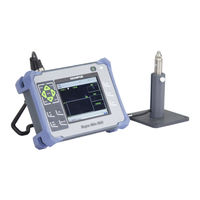
Olympus Magna-Mike 8600 Thickness Gauge Manuals
Manuals and User Guides for Olympus Magna-Mike 8600 Thickness Gauge. We have 1 Olympus Magna-Mike 8600 Thickness Gauge manual available for free PDF download: User Manual
Olympus Magna-Mike 8600 User Manual (186 pages)
Hall-Effect Thickness Gauge
Brand: Olympus
|
Category: Measuring Instruments
|
Size: 3 MB
Table of Contents
Advertisement
Advertisement
Related Products
- Olympus 8080 - CAMEDIA C Wide Zoom Digital Camera
- Olympus 80 - Stylus 80 Quartz Date 35mm Camera
- Olympus Stylus 830
- Olympus Stylus 820
- Olympus Stylus 830 - Stylus 830 8MP Digital Camera
- Olympus ACCURA SuperZoom 800S
- Olympus Stylus 810 - Stylus 810 8MP Digital Camera
- Olympus Stylus 800
- Olympus Stylus Tough 8000 Blue - Stylus Tough 8000 12MP 2.7 LCD Digital Camera
- Olympus Stylus 840
